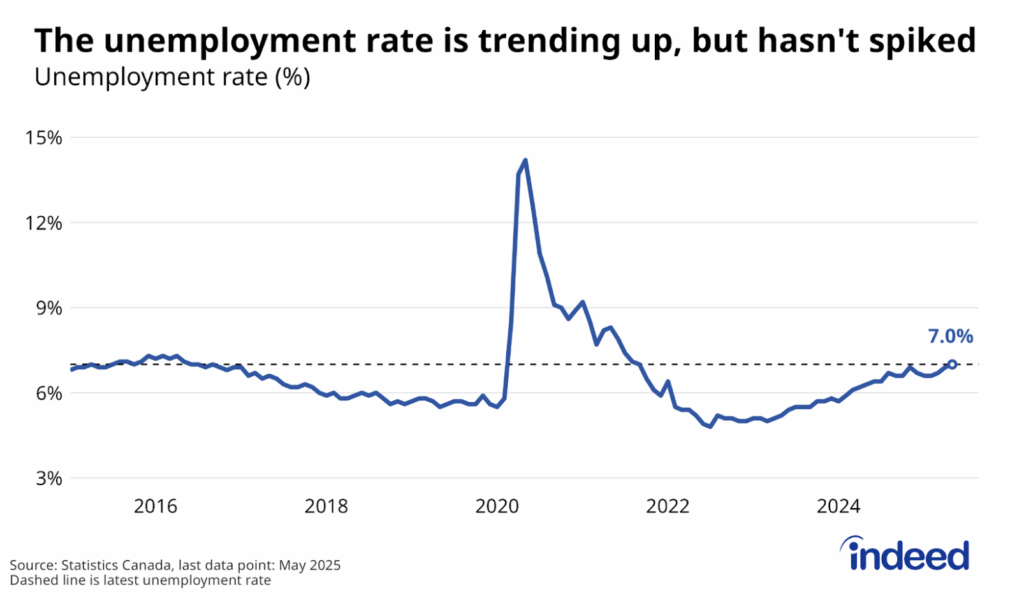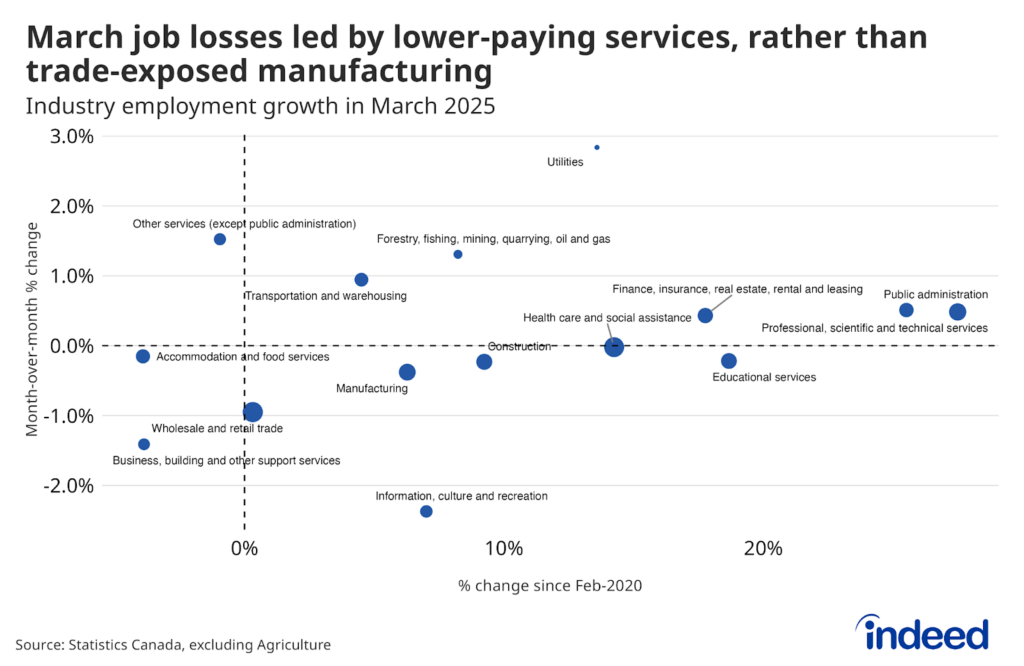Key points
- Clicks per posting on Indeed Canada have declined compared with the economy-wide average in several sectors with jobs that generally can’t be performed remotely.
- A number of factors may be driving the relative drop in interest in these on-site — and often lower-paying — jobs, including ongoing worries about health risks, potentially interacting with government income support programs.
- Meanwhile, postings in several remote-friendly service areas have seen relative increases in click per posting, suggesting stiff competition for workers trying to enter these fields.
It took nearly a year, but by mid-February, job postings on Indeed Canada had completely recovered to their pre-pandemic level. While most of the sectors particularly exposed to the pandemic still lag, postings in some areas are now well above where they were a year ago. Others are in between.
In some cases though, job seeker interest, measured by clicks on different job ads, hasn’t matched trends in employer demand. To understand how the pandemic has affected the balance between employer postings and worker interest in different jobs, we looked at changes in “interest ratios” — that is, clicks per posting in a sector compared with the economy-wide average of clicks per posting.
More clicks per posting in one sector usually suggest it’s easier to find potential candidates than sectors with fewer clicks per posting. Consistent with this, clicks per posting tend to be higher for lower-wage jobs and lower for higher-wage ones.
Overall, changes in job seeker interest between the first half of February and the same period last year evolved similarly to what we saw when we looked at the trends last July, though recent patterns have been a bit less dramatic. Interest ratios declined for postings in a number of sectors that require in-person work, often at fairly low pay. On the flip side, several white-collar fields saw clicks per posting rise substantially compared with the average.
Postings in loading and stocking drop most in relative popularity
Several areas in which clicks per posting fell most compared with the average are lower-paying, according to their average posted wages on Indeed, and unlikely to have many jobs that can be performed remotely, as suggested by their low shares of postings with remote-related terms in their job descriptions. Prominent examples to experience large interest ratio declines include loading and stocking, cleaning and sanitation, and retail. Others are sectors with higher pay, but generally require employees to go to a workplace, like construction and nursing.
Many job postings in these sectors went from receiving substantially more clicks than the typical job ad to numbers closer to the economy-wide average. For example, loading and stocking jobs went from 89%% more clicks per posting than the average job to 32%.
In some cases, this relative tightening stemmed largely from strong employer demand. For instance, postings in loading and stocking, construction, and nursing were well above last February’s levels, while relative job seeker interest did not rise at the same pace.
Conversely, postings remain down in retail, and especially in food preparation and service. At the same time, relative job seeker interest has also shifted somewhat from these sectors, even after accounting for their weak posting trends. The result is their average clicks per posting fell closer to the typical post on Indeed Canada, whereas the year before they received about 15% more clicks per posting.
Job seeker interest shifts to remote-friendly services
The areas of the Canadian economy with the greatest relative increases in job seeker interest per post tend to have white-collar, remote-friendly roles at a variety of pay levels. Postings in some, like media and communications, marketing, and human resources, have seen previously elevated levels of clicks per posting surge even further above the economy average. In other cases, like architecture and industrial engineering, clicks per posting have gone from relatively far below to closer to average.
In between these extremes are postings in a wide range of sectors whose relative popularity with job seekers hasn’t changed much from a year earlier. Moreover, there are some exceptions to the broad patterns of shifting job seeker interest described in this post. For instance, despite the potential health risks in these sectors, interest ratios for jobs in personal care and home health, and the dental field are similar to where they were pre-pandemic.
Pandemic end could boost interest in on-site roles, but white-collar competition might persist
These changes in the interaction between job seeker interest and employer demand across different parts of the economy highlight some unique trends in the Canadian labour market.
Canadian job losses during the pandemic have been concentrated among lower-wage occupations. At the same time, job postings in several lower-wage sectors on Indeed have declined in relative job seeker interest. This could be a signal that income support programs like the Canada Recovery Benefit have made these roles less enticing for some out-of-work job seekers. However, many of these in-person jobs also carry worrisome risks of catching COVID-19. In addition, changing interest in job-hopping towards these roles potentially contributed to their drop in relative interest. It’s tough to disentangle the relative importance of these three factors.
Meanwhile, the relative flood of job seekers toward certain white collar jobs highlights some of the challenges facing young adults looking to break into a number of career-track positions. Employment rates of university grads under age 25 have plunged during the pandemic after improving in recent years. While unemployment in many of these areas is below the harder-hit industries, elevated interest ratios in these fields suggest it’s still tough landing entry-level roles.
With daily life — and by extension the Canadian labour market — likely to get back to some semblance of normality once the pandemic ends, some of the shifts in the balance between job seeker interest and employer demand could reverse. This is particularly the case for positions in which health concerns remain. However, for some white collar jobs less subject to health worries, the path back to pre-crisis conditions is less clear.
Methodology
In this post, we track how interest ratios — clicks per posting in various sectors relative to economy-wide clicks per posting — have changed since the start of the pandemic. Our list of sectors tracks 43 different areas of the economy, grouped by related job titles. Data are changes in the 14-day average of the interest ratio of each sector between February 14, 2020, and February 14, 2021.






